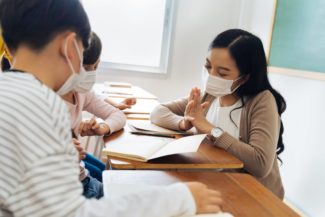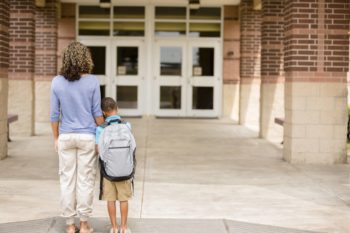Many schools are predicted to return to in-person learning after remote and hybrid learning experiments due to the COVID-19 pandemic. While many have waited excitedly for this day to come, some parents and children may have mixed emotions about going back to school.

This uncharted territory may put both parents and their children in a state of unease, which may lead to new mental health challenges. Kids who show signs of depression or anxiety may be more vulnerable.
“Even though in-person learning is usually best for their physical and mental health overall, it could take a while for them to adapt back,” according to the Cedars-Sinai blog. “Kids are resilient, but they also have emotions without the maturity to process those emotions in a healthy way.”
As families navigate this transition, parents can look for ways to help their children cope, while reducing some of their own stress.
What Will Schools Be Like When They Reopen?
How your child’s reopened school will operate will be dependent upon your particular district and school. Many schools are expected to develop procedures that will keep the student, faculty, and community’s best interest, health and safety in mind.
This may include, in many districts, supporting students who need to catch up academically.
In an article in The New York Times, a Salem, Mass. school district shared its plans to use federal relief money to help students meet academic standards after an uncertain year of online and in-person schooling. The district plans to offer more summer school classes, conduct new math and reading assessments to identify skill gaps, and hire dozens of part-time reading and math tutors. The district plans to expand after-school programming to ensure students have time to take advantage of these offerings.
Likewise, P.S. 89, a Brooklyn public school highlighted in Chalkbeat, plans to add teachers to its program and provide classroom support, including student assessments in reading and math.
“As students will return at widely varying reading levels, with some struggling to master letters and their sounds, [P.S. 89’s principal] is hoping that additional teachers will work with students who need extra help while also nudging along students who are farther ahead,” according to the Chalkbeat article.
Just as important is helping students adjust emotionally. P.S. 89 has plans to ensure students and students’ families get the support they need outside the classroom. To do this, the school has added a new social worker and will restart the school’s peer-mediation program.
“[P.S. 89’s guidance counselor] is anticipating more acute challenges with following directions, motivation, bullying, dealing with romantic rejection, and processing grief,” according to the Chalkbeat article.
This health- and safety-conscious approach is supported at the national level. To provide a safe and supportive learning environment, the Centers for Disease Control (CDC) developed an operational strategy for K-12 school administrators which includes prevention strategies to reduce COVID transmission in schools, such as:
“Universal and correct use of masks required,
- Physical distancing,
- Handwashing and respiratory etiquette,
- Cleaning and maintaining healthy facilities,
- Contract tracing in combination with isolation and quarantine.”
Managing Socialization Challenges like Negative Thoughts and Separation Anxiety
Even with CDC guidelines for health and safety, parents and children may feel anxiety – especially as guidance changes.
“Parents have a complicated mission dealing with all this anxiety and uncertainty: reassuring children that it’s safe to be away from them, while also encouraging them to be careful and preparing them to be flexible in case the situation changes,” according to an article on the Child Mind Institute website.
The Child Mind Institute suggests setting a positive tone with your children and trying to minimize your own anxieties. Give your child the space to express any negative feelings they may have, let them know that you hear them, but also help them brainstorm things they can do to address those feelings.
“If your child is struggling a bit, or they say they miss you, that’s okay,” explains Dr. Rachel Busman, PsyD, director of the Anxiety Disorders Center at the Child Mind Institute. “I think you want to say, ‘I miss you too, and I’m so proud of you for going to school.’”
One way to ease into them going back to school – where they will be away from you for hours a day – is to practice separation.
Parents may want to encourage their children to play in a room by themselves while they are in a different room or have their child stay “with another caregiver while Mom or Dad goes out,” Dr. Busman says. “Those little things build the currency towards the big separation.”
The Child Mind Institute article points out that creating routines for your children leading up to the start of school may also ease the transition to a structured school day.
“I think it just takes the uncertainty out of it – we always do this, and we always do that,” explains Dr. Jennifer Louie, PhD, a clinical psychologist at the Child Mind Institute. “For example, at drop-off Daddy always does a hug and a kiss before he says goodbye, and then we wave from the door.”
Parents magazine advises establishing age-appropriate, open communication with your children. For one, the article suggests starting conversations with kids several weeks before school begins. However, you should gauge whether your child is ready to talk before broaching the subject with them.
Dr. Karen Ann Ravin tells Parents magazine that asking short questions such as: “do you have questions about going back to school? Are you thinking about anything?” will help you see where your child is in terms of thoughts and concerns.
“You can guide the conversation, answer their questions, and speak about what they’ve learned from television and social media,” according to Parents magazine.
What’s Right for Your Child?
“This is a big transition, and just as it took a while to figure out remote work and learning (if that even happened), it will take a while to reintegrate back to in-person school and the way of life that surrounds it,” according to an article on the CNN Health website.
CNN Health notes that those routines that developed over the year of remote learning will likely change to accommodate the return to in-person school. Sleep cycles, mealtimes and building in time for commutes will require a new set of practices, which will take time to integrate.
Every child differs in how they adapt in new situations. Keep in mind that they’ve already been through a major change with adapting to remote learning – and now they have to adapt to going back to in-person learning.
“In some cases, kids may resist going back to school because the quarantine was actually a lot easier for them than going to school – kids with a lot of social anxiety, or who were bullied, or kids with learning disorders who had an easier time at home where they could do things at their own pace,” according to the Child Mind Institute.
Boston Children’s Hospital suggests talking to the school to better understand what your child’s day might look like, since it may be different than it was before the pandemic. Having this knowledge can help your kids allay concerns about any changes in their daily routine, which could include changes in how they will get to and from school, how the school will operate, new safety protocols and other rules. Additionally, their routines at home may change in order to acclimate to in-person learning.
The Child Mind Institute writes that many children will struggle with the transition, but over time, as they grow more comfortable with their new routines, that struggle may lessen. If it does not, they advise seeking help from a therapist or teacher – or both.
“Therapists often work with teachers to see what they can be doing to help and make sure they are on the same page with parents,” according to the Child Mind Institute article. “Therapy also involves helping anxious kids talk to themselves and reassure themselves that they’re okay in difficult moments.”
If you’d like to learn more about helping children deal with mental health issues, read these GeneSight blog posts:
Our articles are for informational purposes only and are reviewed by our Medical Information team, which includes PharmDs, MDs, and PhDs. Do not make any changes to your current medications or dosing without consulting your healthcare provider.
The GeneSight test must be ordered by and used only in consultation with a healthcare provider who can prescribe medications. As with all genetic tests, the GeneSight test results have limitations and do not constitute medical advice. The test results are designed to be just one part of a larger, complete patient assessment, which would include proper diagnosis and consideration of your medical history, other medications you may be taking, your family history, and other factors.
If you are a healthcare provider and interested in learning more about the GeneSight test, please contact us at 855.891.9415. If you are a patient, please talk with your doctor to see if the GeneSight test may be helpful.



 “Universal and correct use of masks required,
“Universal and correct use of masks required,





